Boston – Part 1
(I’m catching up somewhat belatedly after 3 days in Boston)
Boston – or Bawshtun, as the locals would say – is a wonderful place. I’m spending 3 nights here with Jim and Mac Berkman, who are, quite simply, fantastic. I’m always pretty nervous about meeting new hosts, but that all went out of the window within about 5 seconds – something which was probably helped by the fact all three of us are very much on the same wave-length politically. Handy, considering that we talked politics for about 3 hours straight on my first night. Although I’ve found after 3 years of Balliol that you often learn the most from those you disagree with, it’s always nice to have one’s prejudices re-affirmed! Furthermore, I received from both Jim and Mac an invaluable list of the Great American Novels that I should endeavor to read whilst traveling, as between them they seem to have read everything hence were the perfect people to ask.
Boston is – i’llrepeat – fantastic. It combines modern architecture with old (well, old by American standards) to great effect, like this below, which, incidentally, is the Old North Church where Samuel Adams incited the crowd who started the so-called Boston Tea Party, when 40 tonnes of perfectly good tea were unceremoniously dumped into Boston Harbour. What a waste.
There is a really welcoming, laid-back feel throughout Boston, despite its having a reputation of being cold and unfriendly. Ordinary people stopped to ask if I needed directions or help, and I just feel so welcome, especially compared to New York where everyone appears to be engaged in a permanent headlong stampede. This is my favourite stop of the trip so far – and dare i say it? – possibly the city i’ve liked the most out of all those I’ve ever visited (and i’ve seen a fair few now).
On my first full day I decided to take a guided (costumed) tour of the ‘Freedom Trail’, a path which runs right through the city, and which by following a red line takes you past all the historic big hitters. I’ll confess, I had prepared myself for some jingoistic pro-Americanism – and expected a bit of ribbing for being a Brit. After all, the website proudly invites you to discover the history of the “Greatest Democracy in the World”. I need not have worried however, for in fact our tour-guide gave us a very even-handed account, taking the time to point out some common misconceptions and enduring pieces or revolutionary propaganda, some of which i’ll relate below.
First, however, a little aside. Fellow Englishers may not know, but Bostonians has a reputation within the USA for possessing a really distinct accent (if you’ve not heard it, go watch Gone, Baby, Gone – which is also a damn good film worth seeing in its own right, or imagine a stereotypical New York accent, but give it more gravel and more baritone, yet make it less abrasive at the same time). Indeed, I picked up on the accentual change as soon as i got off my bus on arrival. Yet apparently the accent is in decline, and rapidly, something which many Bostonians lament as a loss of regional diversity, character and uniqueness. Why is this happening? Nobody is really sure, but two theories seem the most likely: people watch more TV and movies than even, and the population of the USA is increasingly mobile. In the UK however, i read recently (no idea where), that there has actually been an increase in regional accentual diversity – in Liverpool especially, the accent is becoming stronger and more sharply distinct from other regions. I’m not sure whether I like that, and what – if any – bearing it has upon Bawshtun.
This is the Boston State House (apologies for the tree). Originally it leaked when it rained, so they gave it a copper roof. Then the copper oxidised and went green-blue, so they had to replace it. With 24-carrat gold, no less. Nice to see the taxes of the hard-working citizens of Massachusetts going to good use.
NOT the Tomb of Benjamin Franklin. The tomb of his parents. They never did anything interesting, but their son did so they got a great big tomb. What a pair of free-riders. (Benjamin Franklin is buried in Philadelphia).
The Tomb of James Otis, orator and lawyer, the man who (ostensibly) coined the expression “no taxation without representation”, and argued that a man’s home is his castle (and that the British Crown had no business inside said castles). Otis was, tragically, hit by lightning whilst walking around in a storm, as one does. Amazingly he didn’t die, but he did end up having a massive hole in his head which doctors plugged with a metal plate. Unfortunately he lost all his skills of oratory, and so was given a position as a school teacher – which he lost after wandering around the Boston Common in only his wig. Shipped off to the countryside for some R’n’R, he was standing on his balcony in another storm, when he was again hit by lightning. This time he died.
The tomb of John Hancock, richest man in all of New England during his day, possessed of a fortune arising from his being the best smuggler and privateer in the New World. Elected governor of Massachusetts 19 times (although, to be fair, governors were elected yearly back then), he was livid when some bumpkin nobody from Virginia called George Washington was made leader of the American revolutionary movement instead of him. I can sympathise – i never recovered from the humiliation of James Arnold being made Balliol representative on the Philosophy Joint Consultative Committee at Oxford instead of me. And the fact that he ended up doing a good job simply added insult to injury, as i’m sure Hancock would agree. But at least Hancock got a bloody great big sky-scraper named after him. What do i get? Anyway, i digress.
Somewhat absent mindedly, Hancock forgot to write a will. The result being that his wife went from being the richest woman in New England on one day, to being literally a homeless beggar on Boston Common the next, because the state of Massachusetts confiscated all Hancock’s property after he died. Hancock’s wife was eventually voted a pension, but it didn’t do her much good because she died before she got it. What a bummer.
The tomb of Paul Revere. Revere not only put the copper top on the Boston State Hall, he is the man – all 5ft 0 of him – who rode through the streets reputedly shouting “The British are coming!’ to warn people of this development, as immortalised by Henry Wadsworth Longfellow’s poem Paul Revere’s Ride. But of course, Revere never shouted any such thing, and why would he? If i ran around the streets of Oxford shouting “the British are coming!” nobody would pay any attention, except to have me locked up for drunk and disorderly (and Revere was almost certainly tanked when he went on his ride). In 18th Century, pre-revolutionary New England, everyone was British. What Revere actually shouted was “The Red Coats are coming!”.
Further, Revere was not alone; both Dr Joseph Warren and William Dawes accompanied him – but nobody remembers them. Whether this is because nothing rhymes with Dawes or Warren, I leave for you to decide.
- Listen, my children, and you shall hear
- Of the midnight ride of Paul Revere,
- On the eighteenth of April, in Seventy-Five;
- Hardly a man is now alive
- Who remembers that famous day and year
The Tomb of Samuel Adams, a key player in the revolutionary movement. Adams was rubbish at everything, except being a revolutionary. He was very good at that, because he was very good at – how shall we put it – reinterpreting the truth. For example, take this headstone commissioned by Adams:
(It’s wonky in real life, i’m not that bad at taking pictures)
Starting at the bottom, this ‘innocent child’ was perhaps not so innocent after all. He and his friends were frequent abusers of the local tax man, and their favourite game – encouraged by Adams et al- was to break the tax-man’s windows with rocks. One day they had smashed all the windows, and a stray rock severely injured the tax-man’s wife. He lent out of the window with his hunting gun, and told them if they didn’t leave he would shoot. Rather than leaving, they continued to throw rocks. So the tax-man fired, and young Snider was wounded and later died of his injuries. Adams, however, spun the story as one of tyrannical British oppression against an innocent and subjugated populace.
Likewise the ‘Boston Massacre’. Although a contemporary engraving duplicated throughout the Americas and Europe – commissioned by Adams and cut by Paul Revere – depicts 40 red coats firing on 12 civilians, the truth was rather different. Rather, the evening started with a gang of men shouting insults and throwing snow-balls at a lone soldier. Snow balls were soon replaced with rocks, and the soldier called for assistance. 12 red coats and their captain stood together, but the mob began to grow. Somebody started to ring a church bell. In Boston of the late 18th Century, this meant fire, and everyone was expected to rush out in order to aid efforts to extinguish the blaze, after all the town was constructed almost entirely of wood back then. Within minutes the entire population of Boston was on the streets looking for the fire, and the mob around the red coats had grown stronger. In the confusion, a cry of ‘where’s the fire?’ was mistaken by an 18 year old private as an order to fire, and so he did. He was followed shortly by some of his comrades, and the result was 5 dead Bostonians. This, of course, is not how Adams told it.
The first Church of England Church in the USA, somewhat ironically built upon the site of a Presbyterian graveyard. Originally wooden, a stone structure was built around it, and when completed the wood was removed from the inside, piece by piece. The tower isn’t completed, because they ran out of money during the original round of construction. When they got some, everyone had gotten used to the stump so they kept it.
A homage to the victims of the Irish Potato Famine. Apparently, if you do the sums and take all those in Boston of Irish descent within 3 generations, it’s counts as the 3rd largest Irish city in the world, behind Dublin and New York.
The balcony from which the Declaration of Independence was read out for the first time, in 1776.


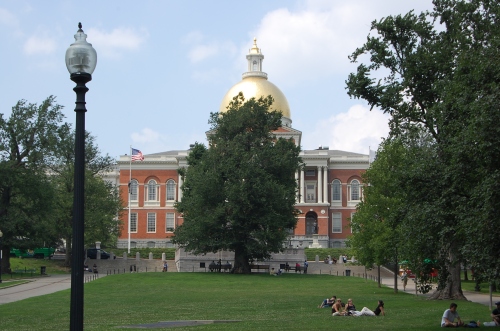

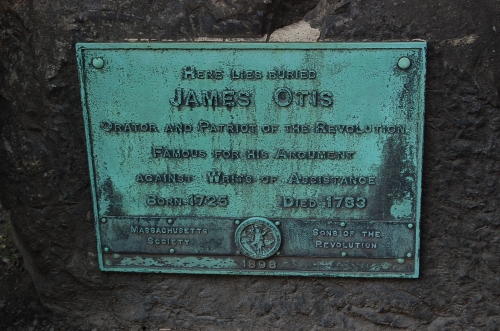

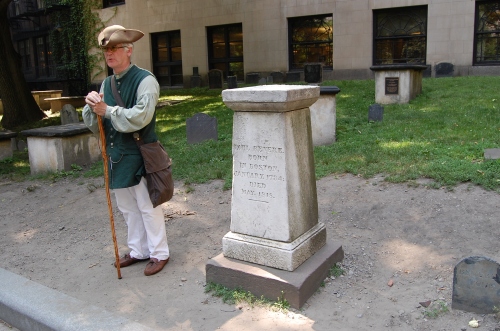
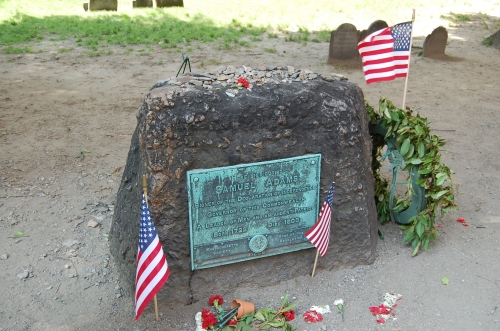

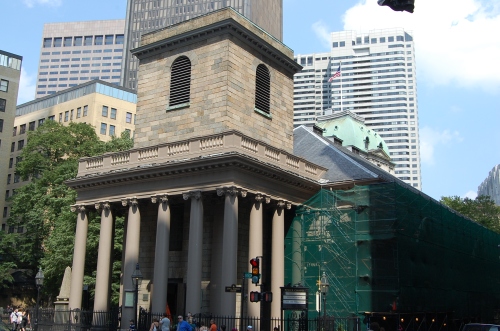


I wonder what sort of a tomb Paul Richard Sagar’s mom + dad will get…
A small one.
Whereas my parents will get a bloody massive one, because I’m definitely off to be a revolutionary, me.
Oh, and cheers for the comparison to George Washington!
And Sam Adams is also, crucially, the name of one of the better beers from the continent.
While Saz’s taste is impeccable as ever, what many might not know is that the picture of the bloke on the label of the Sam Adams bottle is not Sam Adams. It’s Paul Revere.
Sam Adams was short, fat and ugly. Nobody wants to think of short, fat and ugly people when they are getting drunk, or else what would be the point?